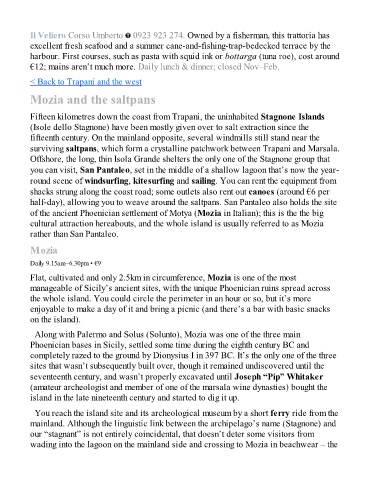Page 521 - The Rough Guide of Sicily
P. 521
Il Veliero Corso Umberto 0923 923 274. Owned by a fisherman, this trattoria has
excellent fresh seafood and a summer cane-and-fishing-trap-bedecked terrace by the
harbour. First courses, such as pasta with squid ink or bottarga (tuna roe), cost around
€12; mains aren’t much more. Daily lunch & dinner; closed Nov–Feb.
< Back to Trapani and the west
Mozia and the saltpans
Fifteen kilometres down the coast from Trapani, the uninhabited Stagnone Islands
(Isole dello Stagnone) have been mostly given over to salt extraction since the
fifteenth century. On the mainland opposite, several windmills still stand near the
surviving saltpans, which form a crystalline patchwork between Trapani and Marsala.
Offshore, the long, thin Isola Grande shelters the only one of the Stagnone group that
you can visit, San Pantaleo, set in the middle of a shallow lagoon that’s now the year-
round scene of windsurfing, kitesurfing and sailing. You can rent the equipment from
shacks strung along the coast road; some outlets also rent out canoes (around €6 per
half-day), allowing you to weave around the saltpans. San Pantaleo also holds the site
of the ancient Phoenician settlement of Motya (Mozia in Italian); this is the the big
cultural attraction hereabouts, and the whole island is usually referred to as Mozia
rather than San Pantaleo.
Mozia
Daily 9.15am–6.30pm • €9
Flat, cultivated and only 2.5km in circumference, Mozia is one of the most
manageable of Sicily’s ancient sites, with the unique Phoenician ruins spread across
the whole island. You could circle the perimeter in an hour or so, but it’s more
enjoyable to make a day of it and bring a picnic (and there’s a bar with basic snacks
on the island).
Along with Palermo and Solus (Solunto), Mozia was one of the three main
Phoenician bases in Sicily, settled some time during the eighth century BC and
completely razed to the ground by Dionysius I in 397 BC. It’s the only one of the three
sites that wasn’t subsequently built over, though it remained undiscovered until the
seventeenth century, and wasn’t properly excavated until Joseph “Pip” Whitaker
(amateur archeologist and member of one of the marsala wine dynasties) bought the
island in the late nineteenth century and started to dig it up.
You reach the island site and its archeological museum by a short ferry ride from the
mainland. Although the linguistic link between the archipelago’s name (Stagnone) and
our “stagnant” is not entirely coincidental, that doesn’t deter some visitors from
wading into the lagoon on the mainland side and crossing to Mozia in beachwear – the

